Ayers Rock (band)
Ayers Rock were an Australian rock band which formed in August 1973. Ray Burton (guitar and vocals), Mark Kennedy (drums), and Duncan McGuire (bass), members of Leo de Castro and Friends, left to form the eponymous trio of Burton, McGuire & Kennedy. They added a guitarist, Jimmy Doyle, changed their name to Ayers Rock and invited Col Loughnan (saxophones and flutes) to join. The group signed with independent label Mushroom Records in December 1973. Burton left the following March, and was replaced by Chris Brown (guitar, vocals). With live appearances, coverage in print media and word of mouth the group had a high national profile despite little radio airplay, and journalists praised their musicianship, music, and live energy.
Ayers Rock | |
|---|---|
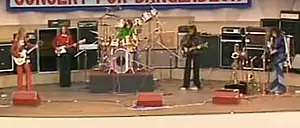 Ayers Rock performing at the Australian Concert for Bangladesh, April 1975. L to R: Chris Brown, Duncan McGuire, Mark Kennedy, Jimmy Doyle, and Col Loughnan. | |
| Background information | |
| Also known as |
|
| Origin | Melbourne, Victoria, Australia |
| Genres | Jazz fusion, progressive rock |
| Years active | 1973–1981 |
| Labels | Mushroom, Festival, A&M, RCA, Red Rock |
| Past members |
|
The band's first album, Big Red Rock (November 1974), received positive reviews and peaked at number 32 on the Australian Kent Music Report album chart. It featured mainstream rock and three longer, instrumental tracks which introduced progressive styles, including jazz fusion. Label owner Michael Gudinski promoted Ayers Rock in Los Angeles and they signed with A&M Records, the first Mushroom Records artists to sign with an international label. The United States release of Big Red Rock in February 1975 was followed by a tour there, later that year. The band played to large crowds, supporting major international artists (including Bachman–Turner Overdrive) before 35,000 people – the first Australian band to perform in large US stadiums. Ayers Rock were named 1975 Musicians of the Year on RAM's "New Year's Honors List".[1] Kennedy left before their second album, Beyond (April 1976, recorded at the Record Plant in Los Angeles), was released. The album blended a number of music genres and had a positive critical reception, charting at number 50. The band toured the US again; Loughnan remained there, and Ayers Rock temporarily broke up in August 1976.
A year later Doyle and Brown recruited members for a new lineup, including Andy Cowan (keyboards and vocals) and Hamish Stuart (drums). In 1980 they released their third album, Hotspell, on their own Red Rock Records label. This album had a soft-rock style, with sophisticated arrangements and featured keyboards. It failed to chart, and the group permanently disbanded in 1981. Although Ayers Rock's first two albums were successful in Australia, none of their six singles charted. During their early years (from 1973 to 1976), the group were praised by local media for their music, stylistic diversity, use of technology, and the energy of their live performances. Ayers Rock received positive reviews in Billboard and Cashbox. Late-1990s music historians recognised the band's talent but considered their music over-indulgent at times, failing to bridge the gap between artistic and commercial success. Duncan Kimball of Milesago.com wrote "that they never really got the chance to reach their full potential."[2]
Australian music scene
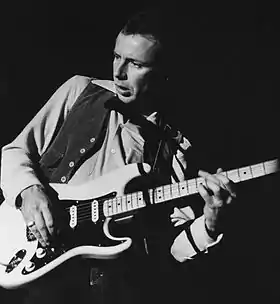
Ayers Rock were formed in the Australian pop-music scene of the early 1970s,[3][4][5] which included artists in a number of genres: mainstream pop (Zoot and Liv Maessen), blues rock (Chain), heavy rock (Billy Thorpe & the Aztecs), and boogie (Carson).[4][5] Bands such as Blackfeather[6] and Madder Lake combined mainstream and progressive rock.[7] Most pop and rock listeners had never heard jazz fusion;[8] when Ayers Rock incorporated the music into their sets, it was rarely performed by fellow Australian artists.[9][10]
At that time, the Australian music media expressed frustration that few local musicians were successful overseas.[5] Many artists (such as The Twilights,[11] The Masters Apprentices,[12] The Groop[13] and Axiom) had gone to the United Kingdom with little commercial success,[5][14] and music papers such as Go-Set regularly addressed the situation.[5] The "third wave" of Australian rock, from 1970 to 1975, saw an increase in pub rock venues in the southern and eastern states.[4]
History
1973: Formation
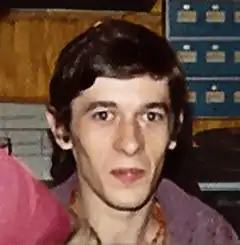
Ayers Rock formed in Melbourne in August 1973.[2][3] Ray Burton, Mark Kennedy, and Duncan McGuire, members of Leo de Castro and Friends,[2] left in June to form the eponymous trio of Burton McGuire & Kennedy.[3] Burton had played guitar with the Dave Bridge Quartet, the Delltones and the Executives,[3] and co-wrote "I Am Woman" (May 1972) in the United States with Australian singer Helen Reddy.[2][15] McGuire, on bass, was a recording engineer, producer, and a member of Australian groups since the late 1950s (including the Phantoms, the Epics, the Questions – which later became Doug Parkinson in Focus; see Doug Parkinson – and King Harvest).[2] Kennedy, on drums, had played in Spectrum, Doug Parkinson in Focus, King Harvest, and Leo de Castro and Friends.[2][3][16]
Burton McGuire & Kennedy were joined in August 1973 by Jimmy Doyle on guitar. Doyle had worked for the Delltones and Dig Richards, was musical director for pianist Winifred Atwell on her Australian tours, and was a session player in Sydney on Neil Sedaka's 1969 album Workin' on a Groovy Thing.[3] In September 1973 Burton McGuire & Kennedy changed their name to Ayers Rock,[2] using the European name for the sandstone rock formation sacred to local indigenous Australians. The group were nicknamed "the Rock" by the Australian press.[17] Since 1993 the sandstone monolith has been called by its Pitjantjatjaran name, Uluru.
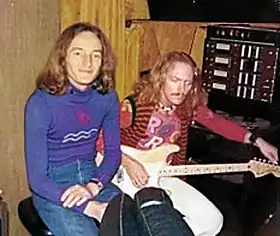
Doyle had worked sporadically for several years with multi-instrumentalist and arranger Col Loughnan,[nb 1][8] who joined London-based blues-pop group Kala in late 1972.[20] Doyle invited his former bandmate to join in October 1973.[21] With Ayers Rock, Loughnan played saxophones, flute, and electric piano.[19] He had begun his career as lead vocalist for the Crescents in 1958, joining the Delltones in 1962.[3] Loughnan diversified into arranging and playing jazz tenor saxophone with the Daly-Wilson Big Band.[8] By December 1973 Ayers Rock had signed with Mushroom Records,[2] which released their first single – "Rock 'n Roll Fight (Going On)", one of the label's early records.[3] Mushroom Records co-owner Michael Gudinski became their manager.
In January 1974 Ayers Rock performed at the Sunbury Pop Festival and "Morning Magic" (written by Burton)[22] appeared on the live album, Highlights of Sunbury '74 Part 2, released by Mushroom Records later that year.[2][23] In March Burton returned to the US and was replaced on guitar and lead vocals by Chris Brown, formerly of Python Lee Jackson.[3] Loughnan and Brown had played together in London as members of Kala.[20][21] The band traced their origins to rock or pop bands from Sydney, except for Kennedy (who was from Melbourne).
1974–75: Big Red Rock
In 1974 Ayers Rock began recording their debut album, Big Red Rock, at Festival Records' 24-track studio in Sydney. They were dissatisfied with the sound, which failed to capture their music's "live" essence,[24] and recorded it live-in-the-studio at Armstrong's in Melbourne that September. Kennedy told Margaret MacIntyre of Rolling Stone Australia, "Doing the album live was an experiment really and it seemed to work."[24] Big Red Rock, released in November, peaked at number 32 on the Kent Music Report album chart.[25][26] The album had "a more jazz-rock edge" and its single, "Lady Montego" (written by McGuire),[3] was a new version of a song originally performed by Leo de Castro and Friends.[2][22] According to Juke Magazine, "the single lifted to push the album, 'Lady Montego' ... received three weeks airplay and was then dumped."[9] "Lady Montego" was Ayers Rock's most-aired single in Australia, and Kennedy said: "Without AM radio support you can't sell too well in this country."[9] Juke called their songs "lyrically banal" but said the group compensated with "sheer talent", instrumentally and electronically.[9]
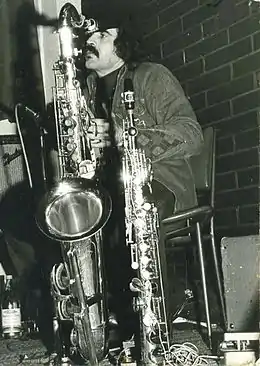
A song from Ayers Rock's live set was a cover of "Boogie Woogie Waltz", written by Joe Zawinul of Weather Report for the US group's album Sweetnighter (April 1973).[27] In November 1974 Loughnan temporarily stopped performing live due to back pain, and the band continued with four members.[24] He returned after surgery, and contemporary photos and video show him playing sitting down during his convalescence.
Manager and label owner Gudinski visited the US in December 1974 to promote his recording artists, including Skyhooks, Daddy Cool, and Madder Lake, to major labels there.[8] At that time only Ayers Rock were successful, with Gudinski signing them to A&M Records within days.[28][29] He told Tony Wilson of The Sun, "Jerry Moss, the president of A&M Records USA, flipped when he heard it, so A&M will release it (Big Red Rock) world-wide."[30] This was a surprise to the Australian media, since many other artists were more commercially successful locally than Ayers Rock. Skyhooks were Australia's most popular band; their first album (Living in the 70's, released in October 1974) sold 226,000 units,[31] the best-selling album by a local artist in Australia to date. However, Living in the 70's was rejected by A&M and not released outside Australia.[32] Ayers Rock were the first Mushroom Records artists to sign a recording contract with an international label.[28][33][34] From the mid-1970s, and into the 1990s, Mushroom were successful with many other artists including Split Enz, Kylie Minogue, and Yothu Yindi, turning the label into Australia's largest independent record company.[35]
In January 1975 the group performed at the fourth Sunbury Pop Festival, and Big Red Rock and "Lady Montego" were released in the US on 28 February.[28] On 20 April, they performed at a benefit concert for Bangladesh at the Sidney Myer Music Bowl with the La De Das, Jim Keays, AC/DC, Phil Manning, Daddy Cool, Toulouse & Too Tight, the Dingoes, and the Moir Sisters.[36]
From July to September, they promoted Big Red Rock in the US and Vancouver.[37] The band played to an audience of 35,000[38][39] at a stadium concert in Seattle, supporting Bachman–Turner Overdrive, on 27 July[37] and opened for Status Quo, the J. Geils Band,[37][40] Lynyrd Skynyrd, and Nils Lofgren.[41] According to Australian rock music historian Ian McFarlane, "Ayers Rock was the first Australian band to play to massive crowds on the USA touring circuit",[3] years before fellow Australians the Little River Band, AC/DC, and Air Supply made their first US tours.[3]
1975–76: Beyond
At the end of their US tour in September 1975 Ayers Rock recorded their second album, Beyond, at the Record Plant in Los Angeles. The album, produced by the group and John Stronach,[42] received a $60,000 advance from A&M Records.[42]
On 18 October, The Sun reported that McGuire had left the band.[43] At a reception when Ayers Rock returned to Australia, he said: "The pressure of the tour was just too much. We were on the road all the time and I guess I wasn't as strong as the rest of the band. When we got into the studio I had the shakes. I mean I was playing the right notes, but not in the right places."[43] To finish the album McGuire's friend Les Young[nb 2] played some of the bass guitar parts, and American Jeff Castleman played bass on "Catchanemu".[43][45] Young also briefly played live with Ayers Rock in Australia, including an October 1975 show at the State Theatre in Sydney.[46] McGuire returned to the group at the Dallas Brooks Hall on 21 October 1975, to warm applause.[47][48]
_Cover_(animated).gif)
In late November Ayers Rock appeared at the final Reefer Cabaret event, at Ormond Hall in Prahran.[nb 3] The performance was recorded for a double album, A-Reefer-Derci (1976).[19][50] In January 1976, Rock Australia Magazine named Ayers Rock Musicians of the Year for 1975 in their "New Year's Honours List".[1] Kennedy left to join Marcia Hines' backing band in February 1976,[2] and they reportedly married late in the decade.[16][51] In Ayers Rock, Kennedy was temporarily replaced by Doug Gallacher.[3] In April 1976 Beyond was released in Australia and the US, making the Kent Music Report top 50.[25][26] Two singles from the album were released: "Little Kings" (October 1975) and "Song for Darwin" (May 1976), but neither charted.[3][25][26]
The US cover for Beyond features a rock in the distance, which becomes the face of an Aboriginal man with eyes closed when the cover is rotated 90° to the right. Artist and Mushroom Records art director Ian McCausland[45] also designed The Rolling Stones' 1973 Australian tour poster.[52] The album cover illustrates a central principle of Aboriginal spirituality: the deep connection between the land and the Aboriginal peoples.[53] In an Aboriginal and Torres Strait Islander Commission publication, "Our Land Our Life", S. Knight described the Aboriginal position: "We don't own the land, the land owns us. The land is my mother, my mother is the land. Land is the starting point to where it all began."[54] According to the Australian government webpage, The Dreaming: "Once the ancestor spirits had created the world, they changed into trees, the stars, rocks, watering holes or other objects. These are sacred places of Aboriginal culture."[53]
In May 1976 Gallacher was replaced by Russell Dunlop, formerly of Aesop's Fables, Levi Smith's Clefs, SCRA, Mother Earth, and the Johnny Rocco Band.[3] In an interview with Greg Kelton of The Advertiser, Loughnan outlined the band's future: "If Beyond doesn't make it for us in the States we might as well forget all about Ayers Rock."[39] From May to July they toured the US again, "only achiev[ing] limited success overseas."[3] After the tour Dunlop and Loughnan left, and on 25 August Mushroom Records announced that Ayers Rock had broken up after Loughnan decided to remain in the US to study.[55] Brown, Doyle, and McGuire indicated that they would revive the group with new members.[3][55]
1977–81: Hotspell

In 1977 Brown and Doyle re-formed Ayers Rock with Bermuda-born Keith Caisey on percussion, Joe Tattersall (formerly of Healing Force and the Barry Leef Band) on drums, and John Young (formerly of Leo de Castro's eponymous group) on bass guitar. By 1978 Brown, Caisey and Doyle were joined by Andy Cowan (formerly of Madder Lake) on keyboards and vocals, Steve Hogg (formerly of Bakery) on bass guitar, and Hamish Stuart on drums.[3] In March 1980 the band released another single, "On the Avenue", followed in May by their third LP – Hotspell – on their own Red Rock Records (distributed by RCA Records). Recorded at the Music Farm in Byron Bay, it was engineered by former member Duncan McGuire.[56]
In The Canberra Times, Luis Feliu noted the "new-sounding" Ayers Rock and their "laid-back" style.[17] There had been a major change in songwriting, with Brown contributing less (wrote one and co-wrote one with Doyle); Cowan was the most active (writing five tracks), and Stuart and Doyle co-wrote two.[2] Doyle, with no writing credits on previous albums, wrote "On the Road" (which was included in the band's live sets from 1978). Jillian Burt of Juke Magazine described it as "reminiscent of the cool, calm, collectedness that typifies Steely Dan".[57] Hotspell featured soft-rock songs with sophisticated, keyboard-centred arrangements.[56]
According to Feliu's review of the album and a July 1980 performance in Sydney, Ayers Rock were "once Australia's hottest progressive rock" group.[17] Feliu wrote that most of the audience seemed to appreciate the band's new direction: "the capacity audience showed hearty approval ... probably old allegiance, and only a few comments of dissatisfaction, like 'boring', were heard, then that was at the bar up the back".[17] Hotspell did not reach the Kent Music Report album top 100, and has not been released on CD. In July 1981 the group released a final single, "Lies", before disbanding later that year.[2]
Other projects
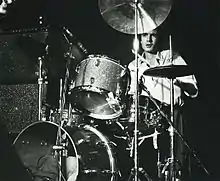
In late 1974 Ayers Rock members Brown, McGuire, Kennedy and Loughnan[58] played on several tracks of Jim Keays' debut solo album, The Boy from the Stars.[59][60] At the January 1975 Sunbury Pop Festival Keays performed most of the album live, with three Ayers Rock members (Brown, McGuire and Kennedy) joining the ensemble to record "Nothing Much Left" and "Urantia".[59][60] Returning to the US, Burton was a session player for Billy Joel and Jimmy Webb and wrote "Best Friend" for the film Airport 1975 (1974).[61] In 1976, he formed the Ray Burton Band with Rex Bullen, Terry Gascoine, Steve Hogg and Tim Piper.[62] From 1977 to 1980, McGuire was bass guitarist for the Southern Star Band with Doug Parkinson on vocals, Tommy Emmanuel on guitar and Kennedy on drums.[62][63] In 1978 Burton released a solo album, Dreamers and Nightflyers, which spawned the singles "Too Hard to Handle" and "Paddington Green". After touring with Crossfire in 1979, he returned to the US as a songwriter.[61][62]
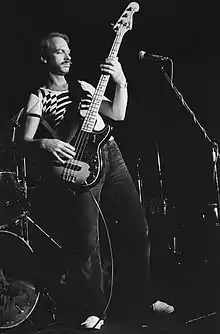
Cowan was later a member of Kevin Borich Express, Ian Moss Band and Renée Geyer Band before pursuing a solo music career.[64] Georgie Fame's album No Worries (1988) included Ayers Rock alumni Loughnan, Doyle, and Dunlop.[65] McGuire died in July 1989 of a brain tumour.[3] During the late 1980s, Hogg formed The Rhythm Snakes with Clayton Black on drums, Howie Smallman on harmonica, and Bob Thorne on guitar.[66] In 1989, Hogg assembled a studio band to record a solo album with Thorne, Mark Alderman on harmonica, Ian Ironside on drums, Bob Patient on piano, and Bernie Payne on saxophone.[66] Steve Hogg died on 20 July 1990 and his album, Various Fools & Vices, was released in 1992.[66]
In 1993, Kennedy drummed for The Blazing Salads with Brian Cadd, Glenn Shorrock, Rex Goh, and Kirk Lorange.[62] Hamish Stuart played drums on Chris Abrahams and Melanie Oxley's 1998 album, Jerusalem Bay.[67] Doyle died on 5 May 2006,[2] and on 28 May the Jim Doyle Tribute Concert was played at the Basement in Sydney. Musicians included Renée Geyer, Billy Field, bandmate Loughnan, and Barry Leef, with proceeds benefiting Doyle's family.[68] Dunlop died on 16 May 2009; he had collapsed after drumming at his son's wedding in Sydney.[69][70] As of 2015, Loughnan is a lecturer in jazz saxophone at the University of Sydney's Conservatorium of Music and has been a member of its Jazz Faculty since 1978.[71] In 2007 he released a solo album, Ellen St.[71]
Musicianship
Genres
Although Ayers Rock's music is described as jazz-rock,[3] this is a simplification. In the 2011 radio documentary "Rare Collections", presented by David and Jordie Kilby on Jazz-Rock in Australia for 666 ABC Canberra, Loughnan described other Mushroom Records artists as playing pop rock styles and Ayers Rock playing some jazz: "We were a bit of both".[8] Critics called Big Red Rock's side one its "song" side and side two its "jazz" side.[72][73] "Lady Montego", "Talkin' 'Bout You", "Goin' Home" and "Nostalgic Blues" are rock songs;[9] the first three were written by McGuire, and the fourth by Brown.[22]
Loughnan's "Crazy Boys"[22] highlighted the band's larrikin side, with working-class men talking at a hamburger shop; each used local slang or spoke in a stereotypical ethnic accent, poking fun at Australians from a variety of backgrounds. At one point "Hey, listen mate, give me one 'Gudinskiburger', please, hold the bacon, please" is heard;[2] Michael Gudinski, whose parents are Jewish immigrants, does not eat pork and went along with the joke. Another voice mentions "Dr. Hopontopovus, the Greek gynaecologist".[2] More slang is heard later in the track, including "Who yer sayin' that to, yer drongo?"
Although "Crazy Boys" has two lines of lyrics, most of the track is instrumental. Described by a Juke Magazine reviewer as "free form jazz",[9] it features solos by Brown, Doyle, and Loughnan and heavily processed guitars, electric saxophone, and vocals. Asked about the group's use of electronics by Eloe Fanouche of RAM, Loughnan answered: "You've got to be able to use them well in order to sound good. We use them to colour the sounds as much as possible."[21]
The title track, Loughnan's "Big Red Rock",[22] is an eight-and-a-half-minute instrumental described by Juke Magazine as "expertly capturing the stark loneliness and cosmic tranquility one gets standing before their namesake rock".[9] According to Loughnan, the atmosphere they wanted to create was "that spacey sort of feeling—like desert [...] and we wanted to get the sound of the didgeridoo—which we did electronically".[21] Doyle imitated a didgeridoo by playing guitar with a wah-wah pedal. Tony Catterall of The Canberra Times praised "Big Red Rock", saying that it "suggests the huge expanse of the outback, then takes you [...] to the Aboriginal secrets [...] [and evokes] the power surrounding the area [of Uluru] in a burst of truly inspired musicianship".[18]
Gil Wahlquist of The Sydney Morning Herald called the album "heavily accented towards jazz."[72] It has changing moods, with quiet moments which are "eerie, euphonic, and evocative."[74] Aboriginal clapsticks and the imitation didgeridoo allude to the indigenous character of Uluru and the surrounding area. Another section is double-tempo jazz fusion with guitar and saxophone solos, complemented by a rhythm section driving to a crescendo. The section concludes with a rapid rallentando (slowing of tempo) to another gentle phase. Changes in tempo and volume are heard throughout the title track,[75] in contrast to disco (featuring one tempo and volume, which was becoming more popular).
Like Big Red Rock, the vastness of rural and outback landscapes were reflected in the artwork and music of Beyond. According to a review by Forester in The Age, the band and album have "titles to suggest space, time and distance" and some tracks had an "indigenous appeal".[76] The lead track's title, "Moondah", translates into English as "beyond".[77] In April 1976 Loughnan, who wrote the song,[22] said in a TV Times interview: "The aborigines have had a raw deal in the past. The song expresses the hope that they get better treatment in the future".[77] "Moondah (beyond)" begins with clapsticks,[78] log drum, imitation didgeridoo,[21] and sounds evocative of indigenous singing.
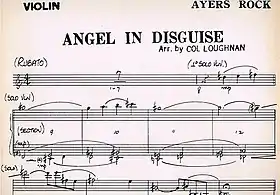
This combination creates sounds similar to indigenous Australian music, which later segues into a European style before returning to its original theme.[77][78] The overall effect is a fusion of indigenous Australian music, rock, and improvisational jazz by European Australians,[76] before indigenous rock artists Yothu Yindi and No Fixed Address created their own fusions of indigenous and rock music.
Beyond featured a 23-piece string section,[42] arranged and conducted by Loughnan,[45] on "Place to Go", "Song for Darwin" and "Angel in Disguise". Loughnan had originally written "Angel in Disguise"[22] years before for his wife, expanding it into an instrumental.[8] According to Derek Johnson's RAM review, "The violin tones and guitar sounds are particularly well produced, dissolving into each other one moment, separating and circling around each other the next."[79]
Airplay
Ayers Rock's treatment by Australian radio stations during the 1970s was related to the popularity of AM. Unlike the US, which had a vibrant FM radio scene, in 1976 Australia only had ABC FM and a few community FM stations[nb 4] which primarily played classical music. Commercial AM stations, playing pop and rock music, dominated the local airwaves.[80] The group established their reputation with live performances, exposure in print media, and word of mouth, with minimal Australian radio promotion.[9][82]
Kennedy told a Juke interviewer, "Radio airplay has never happened for us here—except 2JJ and the occasional Album Shows".[9] Australian Broadcasting Corporation (ABC) youth-oriented AM radio station 2JJ was limited to Sydney during the 1970s, with poor reception in some areas.[80][83] The US attitude toward the band's music was different; according to Greg Kelton of The Advertiser, Beyond had "been played by about 50 radio stations in the (U.S.). 'It is being played on two [stations] in Australia', said Jimmy Doyle."[82]
Live performance
Ayers Rock began incorporating rock-jazz fusion into their sets, increasing the jazz aspect of their music. In his review of a concert on 19 October 1975, Paul Gardiner wrote for Rolling Stone: "Big Red Rock was still tied quite closely to existing American styles."[46] According to Gardiner, at the State Theatre "evidence" of jazz-rock "came through loud and clear".[46] This was their first major Australian concert after their first US tour and recording sessions.[46]
The group were fundamentally a high-volume rock band. In the smoke-filled bar of Martinis in Carlton, Juke Magazine collected a vox populi of the "packed to the rafters" audience. One person said, "I don't mind a bit of volume with my improvisation but this is so goddamn heavy."[9] Gardiner's review described the group's live show:
The band ... have cut their teeth on pure rock and roll and have, [as of] Ayers Rock, moved on to what amounts to a rock-jazz fusion. The inversion of the term is becoming important; unlike the bands to which they are compared in America, which have all lived and breathed jazz in its purer, more traditional forms, ... [the] Rock is made up of rock musicians.[46]
In a Rolling Stone interview by Margaret MacIntyre, Kennedy explained: "Ayers Rock was getting a live response that, to speak for myself, I hadn't seen happen with a crowd ... for a long time".[24] In the same interview, Doyle described the key to their success: "This band is going somewhere ... it's not the same thing every night, unlike many bands, the arrangements change."[24] Reviewers were enthusiastic about the band's performances; according to Gardiner, "The impression they now generate on stage is one of total energy ... energy which sets them apart."[46] Juke Magazine called them "a band that could reward its audiences with (the) sheer exhilaration of seeing real master musicians ... taking their audiences to virgin territory that other explorers had only dreamed about."[9]
Eloe Fanouche of RAM focussed on another aspect:
Unlike many groups they were able to capture the ethereal quality of their recorded sound on stage ... On being asked how live gigs compared to studio work, they all declared that the straight atmosphere of the studio was too clinical.[21]
Critical reception
Contemporary (1973 to 1981)
-crop.jpg.webp)
Big Red Rock received positive reviews in Australia and the US. The Canberra Times quoted a Cashbox review praising their music[nb 5] which ended: "It was something different and something beautiful."[84] Billboard magazine gave the album a good review, saying that it featured "excellent sax work throughout and top-notch lead guitar and drum work".[73][nb 6] Australian reviewers called the album "an extremely good record, well worth owning",[74] "a classic record in Australian rock"[85] and "an inspiring success".[72]
Critical response to their second album, Beyond, was generally positive. Sean Hanrahan wrote for the Melbourne Sunday Press: "Beyond to me stands as something of a crowning achievement for a band that has already been described as the high-water mark in Australian rock."[86] According to Pat Bowring of the Melbourne Sun, "it is one of the best records from an Australian band" and "better than ... Big Red Rock."[87] The band emphasised that their music was "essentially Australian", despite being recorded in Los Angeles,[42] and critics noted their music's Australian character.[21][72][86] Tony Catterall of The Canberra Times wrote that the group "has absorbed its influences so well that they're almost unrecognisable in the final product. And into this synthesis the band has infused some things peculiarly Australian."[18]
Later (1999 to present)
In February 1998, Billboard's Christie Eliezer interviewed Gudinski; he recalled that signing Ayers Rock had "allowed the band to tour the US and record their second album there."[29] He explained that they "were a fantastic jazz-fusion band, a real muso's band, but ultimately they didn't have that something unique to cross over."[29] In his 1999 encyclopaedia Dreams, Fantasies, and Nightmares From Far Away Lands, American author Vernon Joynson called Big Red Rock "an excellent example of jazz rock fusion Australian style. The musicianship is of high quality although it tends to become a little over-indulgent in places". According to Joynson the album had "radio friendly" material and three tracks "filled with fine virtuoso guitar and saxophone",[19] but despite being "quite a popular live act, [Ayers Rock's] recordings were hampered by a dilemma over whether to opt for a more serious pursuit of expanding the horizons or for a commercial sound".[19]
On MilesAgo.com in 2006, Duncan Kimball wrote: "The group's relatively short lifespan and small catalogue meant that they never really got the chance to reach their full potential."[2] According to Ian McFarlane in his 1999 Encyclopedia of Australian Rock and Pop, the members of Ayers Rock "were seen as 'musician's musicians'. The band issued a series of technically proficient recordings, but in the long run any quest for commercial acceptance was marred by the seriousness of the music".[3] In December 2011, Jordie Kilby called Big Red Rock "a great record; quite an influential (album) ... now one that's held in quite high regard."[8]
Members
- Ray Burton – guitar, vocals (1973–74)
- Mark Kennedy – drums (1973–76)
- Duncan McGuire – bass guitar (1973–76; died 1989)
- Jimmy Doyle – guitar, vocals (1973–81; died 2006)
- Col Loughnan – saxophones, flute, piano, percussion, vocals (1973–76)
- Phil Stone – guitar (1974)
- Chris Brown – guitar, vocals (1974–81)
- Les Young – bass guitar (1975)
- Doug Gallacher – drums (1976)
- Russell Dunlop – drums (1976; died 2009)
- Joe Tattersall – drums (1977)
- Keith Caisey – percussion (1977–81)
- John Young – bass guitar (1977–78)
- Andy Cowan – keyboards (1978–81)
- Steve Hogg – bass guitar (1978–81; died 1990)
- Hamish Stuart – drums (1978–81)[2][3][19]
Discography
Albums
| Title | Album details | Peak chart positions |
|---|---|---|
| AUS [25][26] | ||
| Big Red Rock |
|
32 |
| Beyond |
|
50 |
| Hotspell |
|
- |
Singles
- "Rock 'n Roll Fight" (December 1973)
- "Lady Montego" (November 1974)
- "Little Kings" (October 1975)
- "Song for Darwin" (May 1976)
- "On the Avenue" (1979)
- "Lies" (July 1981)
Other appearances
- "Morning Magic" (live), on Highlights of Sunbury '74 Part 2 (Mushroom Records (L 25123), 1974)
- "Gimme Shelter" (live), "Boogie Woogie Waltz" (live) on A-Reefer-Derci (Mushroom Records (L 45657/8), 1976)
Notes
- Various sources misspell Colin Loughnan's surname: Greg Borschmann has "Loughan",[10] Tony Catterall has "Loughlan",[18] and Vernon Joynson has "Loughman".[19]
- Young had previously worked with Doyle and Loughnan in The Soulmates in 1967.[44]
- The Reefer Cabaret was a regular concert event held at various community halls in Melbourne (from August 1974 to 1976) including Dallas Brooks Hall, East Melbourne and Ormond Hall, Prahran.[49] According to Kimball some venue operators had "qualms about the moral dangers of loud music and dope-smoking."[49]
- Examples of public broadcasting FM stations: 2MBS, 3MBS, 4ZZZ.[80][81] The first commercial FM radio stations began in 1980.[81]
- According to Tony Catterall, Cashbox reported: "People knew they were witnessing more than just another rock and roll band. Those vocals were classic for the genre and you just knew there was more than a dash of jazz in their influences. They could boogie with the best of them but it was boogie with substance and dimension. It was something different and something beautiful."[84]
- Full text: Interesting set in a kind of jazz rock vein, with side one featuring shorter cuts heavy on the vocals and side two serving up three long, primarily instrumental, jazz-oriented cuts. Excellent sax work throughout and top-notch lead guitar and drum work. A&M has done quite well with this kind of material in the past, with Tim Weisberg being one notable example. Set should receive FM play, and also receive some progressive jazz airing.
References
General
- Kimball, Duncan. "MilesAgo – Australasian Music and Popular Culture 1964–1975". ICE Productions. Archived from the original on 6 March 2008. Retrieved 19 May 2015.
- McFarlane, Ian (1999). "Whammo Homepage". Encyclopedia of Australian Rock and Pop. St Leonards, New South Wales: Allen & Unwin. ISBN 1-86508-072-1. Archived from the original on 5 April 2004. Retrieved 31 July 2012. Note: Archived [on-line] copy has limited functionality.
- Spencer, Chris; Nowara, Zbig; McHenry, Paul (2002) [1987]. The Who's Who of Australian Rock. notes by Ed Nimmervoll. Noble Park, Victoria: Five Mile Press. ISBN 1-86503-891-1.[88] Note: [on-line] version of The Who's Who of Australian Rock was established at White Room Electronic Publishing in 2007 and was expanded from the 2002 edition. As from, September 2010 the [on-line] version shows an 'Internal Service Error' and was no longer available.
Specific
- "New Year's Honors List". RAM. Sydney: Soundtracks Publishing (Anthony O'Grady, Phillip Mason). 16 January 1976. p. 12.
- Kimball, Duncan. "Ayers Rock". MilesAgo: Australasian Music & Popular Culture 1964–1975. Ray Burton (contributor), Col Loughnan (contributor). ICE productions. Archived from the original on 21 April 2003. Retrieved 17 June 2015.
- McFarlane, 'Ayers Rock' entry. Archived from the original on 3 August 2004. Retrieved 31 July 2012.
- Kimball, "Australasian Popular Music of the 1960s and 1970s – an Overview". Archived from the original on 7 March 2008. Retrieved 28 October 2016.
- Kent, David Martin (September 2002). The place of Go-Set in rock and pop music culture in Australia, 1966 to 1974 (PDF) (MA). Canberra: University of Canberra. Archived from the original (PDF) on 4 September 2015. Note: This PDF is 282 pages.
- Kimball (2006). "Blackfeather". Archived from the original on 7 March 2008. Retrieved 22 May 2015.
- Kimball; Fettes, Mick; McKenna Kerry (2006). "Madder Lake". Archived from the original on 7 March 2008. Retrieved 22 May 2015.
- Kilby, David; Kilby, Jordie (8 December 2011). "Rare Collections". Jazz-Rock in Australia. 666 ABC Canberra. Australian Broadcasting Corporation (ABC). Archived from the original on 14 December 2011. Retrieved 22 May 2015.
- Nimmervoll, Ed, ed. (4 June 1975). "Export Big Red Rock". Juke Magazine. Melbourne: Williams, Thomas W. p. 21.
- Borschmann, Gregg (30 June 1975). "Goodbye and hullo". The Age. Melbourne. p. 2. Retrieved 12 December 2014.
- Kimball (2006). "The Twilights". Archived from the original on 7 March 2008. Retrieved 19 May 2015.
- McFarlane, 'The Master's Apprentices' entry. Archived from the original on 18 June 2004. Retrieved 19 May 2015.
- McFarlane, 'The Groop' entry. Archived from the original Archived 9 August 2004 at the Wayback Machine on 4 July 2002. Retrieved 19 May 2015.
- McFarlane, 'Axiom' entry. Archived from the original Archived 3 August 2004 at the Wayback Machine on 3 August 2004. Retrieved 19 May 2015.
- "'I Am Woman' at APRA search engine". Australasian Performing Right Association (APRA). Archived from the original on 11 June 2015. Retrieved 22 May 2015. Note: User may have to click on 'Search again' and provide details, e.g. at 'Enter a title:' I Am Woman, or at 'Performer:' Helen Reddy. Also note that as a songwriter, Reddy, is given as H Wald – her then-married name.
- "2000/35/1 Costume, performance, synthetic cloth, used by Marcia Hines, made by Mark Kennedy, Australia, 1975–1979". Powerhouse Museum. Archived from the original on 4 June 2011. Retrieved 22 May 2015.
- Feliu, Luis (7 July 1980). "Best of both Armatradings". The Canberra Times. National Library of Australia. p. 11. Archived from the original on 23 April 2014. Retrieved 22 May 2015.
- Catterall, Tony (6 January 1975). "Rock Music: Surprisingly Good Australian Rock". The Canberra Times. National Library of Australia. p. 11. Archived from the original on 13 April 2014. Retrieved 23 May 2015.
- Joynson, Vernon; Wilczek, Michael (1999). 'Ayers Rock' Entry. ISBN 978-1-899855-10-0. Archived from the original on 4 June 2014. Retrieved 17 August 2014.
{{cite book}}:|work=ignored (help) - McFarlane, 'Phil Jones and the Unknown Blues' entry. Archived from the original on 28 August 2004. Retrieved 21 May 2015.
- Fanouche, Eloe (14 June 1975). "Ayers Rock – big red aura moving overseas". RAM. Sydney: Soundtracks Publishing (Anthony O'Grady, Phillip Mason). p. 15.
- "'Lady Montego' at APRA search engine". Australasian Performing Right Association (APRA). Archived from the original on 11 June 2015. Retrieved 22 May 2015. Note: User may have to click on 'Search again' and provide details, e.g. at 'Enter a title:' Lady Montego, or at 'Performer:' Ayers Rock.
- "Sunbury Festival Albums". Anddum. Archived from the original on 21 May 2015. Retrieved 22 May 2015.
- MacIntyre, Margaret (3 July 1975). "No Stone Unturned: The Ayers Rock Dossier". Rolling Stone. Sydney. p. 41.
- Kent, David (1993). Australian Chart Book 1970–1992. St Ives, New South Wales: Australian Chart Book Ltd. ISBN 0-646-11917-6. Note: Used for Australian Singles and Albums charting from 1974 until Australian Recording Industry Association (ARIA) created their own charts in mid-1988. In 1992, Kent back calculated chart positions for 1970–1974.
- Ryan (bulion), Gary (23 August 2012). "Albums Pre 1989 Part 2 – Ayers Rock". Australian Charts Portal. Hung Medien. Archived from the original on 17 October 2011. Retrieved 22 May 2015.
- Ginell, Richard S. "Sweetnighter – Weather Report". AllMusic. Archived from the original on 3 June 2012. Retrieved 22 May 2015.
- Meldrum, Ian (11 January 1975). "Big Red Rock Shock". Listener In-TV. Melbourne: The Herald and Weekly Times. p. 7.
- Eliezer, Christie (14 February 1998). "Michael Gudinski Interview". Billboard. p. 50. Retrieved 22 May 2015.
- Wilson, Tony (1 May 1975). "How Mushroom started to grow ...". The Sun News-Pictorial. Melbourne. p. 4.
- McFarlane, 'Skyhooks' entry. Archived from the original Archived 6 August 2004 at the Wayback Machine on 19 April 2004. Retrieved 19 May 2015.
- "Living in the 70's – Skyhooks | Releases". AllMusic. Archived from the original on 4 November 2016. Retrieved 22 May 2015.
- Warner, Dave (1998). 25 years of Mushroom Records. Sydney: HarperCollins. ISBN 0-7322-6432-4.
- Baker, Glenn A (30 January 1982). "Bursting into world mainstream captures mogul's imagination". Billboard. pp. M-9, M-12. Retrieved 19 February 2015.
- McFarlane, 'Independent record labels' entry. Archived from the original on 28 August 2004. Retrieved 5 March 2016.
- "AC/DC". Only Melbourne. Ripefruit Media. Archived from the original on 11 September 2014. Retrieved 7 June 2015.
- Nimmervoll, Ed, ed. (16 July 1975). "Jazz 'n' Jive". Juke Magazine. Melbourne. p. 2.
- Shipway, Gary (6 November 1975). "Ayers Rock off to U.S. again". The News. Adelaide. p. 57.
- Kelton, Greg (25 March 1976). "'Beyond' Rock's breaking point". The Advertiser. Adelaide. p. 26.
- Logan, Sandi (7 August 1975). "Crowds high on Ayers Rock". The Sun. Sydney. p. 48.
- "My Father's Place [advertisement]". The Village Voice. New York. 1 September 1975. Retrieved 22 May 2015.
- Thomas, Helen (23 March 1976). "The (60) grand dream to reach the top". The Age. Melbourne. p. 2. Retrieved 22 May 2015.
- Bowring, Pat (18 October 1975). "It's sad, but true, says Duncan". The Sun News-Pictorial. Melbourne. p. 6.
- Hayton, Jon; Isackson, Leon (2010). Behind the Rock and Beyond. Glen Waverley: Sid Harta. ISBN 978-1-921642-28-9.
- Beyond (LP record notes). Ayers Rock. A&M Records. April 1976. ASIN B00412FIUK.
{{cite AV media notes}}: CS1 maint: others in cite AV media (notes) (link) - Gardiner, Paul (20 November 1975). "Performance". Rolling Stone. Sydney. p. 53. Note: Review of a concert performed on 19 October 1975.
- Nimmervoll, Ed, ed. (5 November 1975). "Welcome back Ayers Rock". Juke Magazine. Melbourne. p. 5.
- Bowring, Pat (22 October 1975). "Tight and good". The Sun News-Pictorial. Melbourne. p. 6.
- Kimball (2006). "Reefer Cabaret". Archived from the original on 15 March 2009. Retrieved 1 February 2016.
- Greaves, Rob (10 January 2015). "Socially Aware – Cream of The Crate: Album #115 – A Reefer Derci: Various Artists". The Toorak Times. Toorak Metropolitan News. Archived from the original on 19 March 2015. Retrieved 23 May 2015.
- "Glittering Marcia Shines". The Australian Women's Weekly. Sydney: National Library of Australia. 3 November 1976. p. 88. Archived from the original on 22 May 2015. Retrieved 22 May 2015.
- "The Rolling Stones : Australian tour 1973 / design/illustration: Ian McCausland". Catalogue. Canberra: National Library of Australia. Archived from the original on 29 December 2014. Retrieved 22 May 2015.
- "The Dreaming". Australian Stories. Canberra: Big Black Dog Communications. Government of Australia. 31 March 2015. Archived from the original on 27 February 2012. Retrieved 4 September 2015.
- Knight, S (1996). Our Land Our Life. Canberra: Office of Public Affairs, Aboriginal and Torres Strait Islander Commission (ATSIC). Archived from the original on 27 January 2013. Retrieved 22 May 2015.
- "Ayers Rock splits up". The Age. Melbourne. 26 August 1976. p. 2. Retrieved 5 December 2014.
- Hotspell (LP record notes). Ayers Rock. Red Rock Records. May 1980. RRM 6321.
{{cite AV media notes}}: CS1 maint: others in cite AV media (notes) (link) - Burt, Jillian (11 March 1978). Nimmervoll, Ed (ed.). "Ayers Rock, Skyhooks, Mondo Rock". Juke Magazine. Melbourne: David Syme and Co. p. 16.
- McFarlane, Ian (1994). "Jim Keays Reviews – The Boy from the Stars". Freedom Train. Vol. 1, no. 1. p. 40. Archived from the original on 24 July 2015. Retrieved 22 May 2015.
- The Boy from the Stars (Media notes). Jim Keays. EMI Records. 1974. EMA. 308.
{{cite AV media notes}}: CS1 maint: others in cite AV media (notes) (link) - McFarlane, 'Jim Keays' entry. Archived from the original on 30 September 2004. Retrieved 1 August 2012.
- McFarlane, 'Ray Burton' entry. Archived from the original Archived 23 August 2004 at the Wayback Machine on 28 June 2004. Retrieved 1 August 2012.
- Entries at Australian Rock Database:
- Rex Bullen: Holmgren, Magnus. "Rex Bullen". passagen.se. Australian Rock Database (Magnus Holmgren). Archived from the original on 22 October 2013. Retrieved 28 October 2016.
- Tommy Emmanuel: Holmgren, Magnus; Carruthers, Melody. "Tommy Emmanuel". passagen.se. Australian Rock Database (Magnus Holmgren). Retrieved 28 October 2016.
- Brian Cadd: Holmgren, Magnus. "Brian Cadd". passagen.se. Australian Rock Database (Magnus Holmgren). Archived from the original on 28 July 2012. Retrieved 28 October 2016.
- Kimball; Parkinson, Doug (2006). "Doug Parkinson". Archived from the original on 7 March 2008. Retrieved 28 May 2015.
- Levin, Darren (27 May 2006). "Andy Cowan and Stevie Paige – Gig previews & reviews – Music – Entertainment". The Age. Archived from the original on 6 January 2007. Retrieved 21 December 2015.
- No worries (LP record notes). Georgie Fame. Four Leaf Clover Records. 1988. ASIN B0083L40WC.
{{cite AV media notes}}: CS1 maint: others in cite AV media (notes) (link) - McFarlane, 'Bakery' entry. Archived from the original Archived 20 April 2004 at the Wayback Machine on 20 April 2004. Retrieved 1 August 2012.
- McFarlane, 'Chris Abrahams' entry. Archived from the original on 3 August 2004. Retrieved 1 August 2012.
- "Jim Doyle Tribute Concert". The Sydney Morning Herald. 26 May 2006. Archived from the original on 18 September 2006. Retrieved 23 May 2015.
- Sheil, Pat (19 June 2009). "A drummer for all times". The Sydney Morning Herald. Fairfax Media. Archived from the original on 18 June 2022. Retrieved 29 May 2015.
- Cashmere, Paul (7 May 2009). "Vale Russell Dunlop and Ian Miller". Undercover. Undercover Media (Paul Cashmere, Ros O'Gorman). Archived from the original on 6 March 2012. Retrieved 29 May 2015.
- "Mr Col Loughnan". Sydney Conservatorium of Music. 23 May 2015. Archived from the original on 10 March 2015. Retrieved 28 October 2016.
- Wahlquist, Gil (19 January 1975). "Big Red Rock". The Sun-Herald. Sydney. Retrieved 14 December 2014.
- "Billboard's Recommended LPs" (PDF). AmericanRadioHistory.com. Billboard Publications, Inc. 12 April 1975. p. 86. Archived from the original (PDF) on 4 September 2015. Retrieved 4 September 2015.
- Suave, Leroy (aka Brian Wakefield). "HiFi Rock Record Review". Soundblast magazine. p. 80.
- Loughnan, Col. Ayers Rock. "Big Red Rock". Big Red Rock. Mushroom Records. 1974. (LP)
- Forester (2–8 April 1976). "Ayers Rock shows its solid face". The Age: TV-Radio Guide. Melbourne. p. 5. Retrieved 28 December 2014.
- Gough, Chris (3 April 1976). "Ayers Rock leaving on second U.S. tour soon". TV Times. Australian Broadcasting Commission. p. 38.
- Dunlop, Don (25 March 1976). "Sleeve of the week". The Herald. Melbourne. p. 33. Note: Dunlop confuses "message sticks" with "clap sticks".
- Johnson, Derek (7 May 1976). "Records". RAM Magazine. Melbourne. p. 29.
- Kimball (2006). "Double Jay: The First Twelve Months. Archived from the original on 7 March 2008. Retrieved on 19 May 2015.
- "Radio in Australia". Australian Stories. Government of Australia. Archived from the original on 27 February 2012. Retrieved 23 May 2015.
- Kelton, Greg (24 April 1976). "Chip of the Old Rock". The Advertiser. Adelaide. p. 3.
- Ricquish, David. "Radio Power Plays 1975–81 Melbourne, Sydney & Wellington". Radio Heritage Foundation. Archived from the original on 29 August 2007. Retrieved 23 May 2015.
- Catterall, Tony (20 October 1975). "Not the Allmans' best, but it'll do". The Canberra Times. National Library of Australia. Archived from the original on 27 December 2014. Retrieved 23 May 2015.
- Hanrahan, Sean (12 October 1975). "Stars Dig Ayers Rock: Stevie spreads gospel". Sunday Press. Melbourne. p. 20.
- Hanrahan, Sean (28 March 1976). "It's beyond belief ...". Sunday Press. Melbourne. p. 21.
- Bowring, Pat (22 March 1976). "Rap Around". The Sun News-Pictorial. Melbourne. p. 6.
- Who's Who of Australian Rock / Compiled by Chris Spencer, Zbig Nowara & Paul McHenry. 2002. ISBN 9781865038919. Archived from the original on 8 March 2010. Retrieved 23 May 2015.
{{cite book}}:|work=ignored (help)
External links
- Ray Burton's official website Archived 17 March 2012 at the Wayback Machine
- Col Loughnan's official website
- Ayers Rock at Allmusic.com
- Ayers Rock discography at Discogs